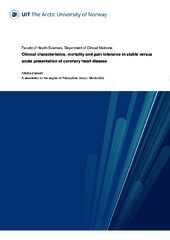Clinical characteristics, mortality and pain tolerance in stable versus acute presentation of coronary heart disease
Permanent lenke
https://hdl.handle.net/10037/26711Dato
2022-09-30Type
Doctoral thesisDoktorgradsavhandling
Forfatter
Fladseth, KristinaSammendrag
Despite immense progress in the prevention, diagnosis and treatment of coronary heart disease, several challenges remain. In more than half of patients referred to coronary angiography for stable and unstable angina, no obstructive coronary artery disease (CAD) is found. At the same time, some patients present for the first time with already extensive CAD. Further, the management of unstable angina patients after implementing high-sensitivity troponins is uncertain. We investigated if we could improve the selection of unstable angina patients to coronary angiography, the outcomes of unstable angina compared to stable angina and myocardial infarction (MI), and how pain tolerance affects when and how CAD presents.
We applied data from patient hospital records, the local and national coronary angiography registry and the Tromsø Study. Pain tolerance was assessed using a cold pressor test in the Tromsø Study. Paper I is a retrospective cohort study, while papers II and III are prospective cohorts studies. We used logistic regression and Cox proportional hazard regression analyses. In paper I, adding symptom characteristics to cardiovascular risk factors, we created a risk score to predict obstructive CAD in unstable angina patients. This score performed better than guidelines and other risk scores. In paper II, we found that unstable angina patients had a similar risk of cardiovascular events but a higher risk of death than stable angina patients. Unstable angina had a lower 1-year risk of cardiovascular events and death than non-ST segment elevation MI. In paper III, individuals with low pain tolerance had a higher risk of coronary angiography, obstructive CAD and death. Pain tolerance was not associated with the clinical presentation or extent of CAD.
Our findings confirm that unstable angina patients have a better prognosis than MI patients and support the newest guidelines recommending fewer invasive coronary angiographies in unstable angina patients. The discrepancy in when and how CAD presents is still unclear, and further studies are warranted.
Til tross store framskritt i forebygging, diagnose og behandling av koronarsykdom gjenstår flere utfordringer. Over halvparten av pasientene som henvises til koronar angiografi for stabil og ustabil angina har ingen obstruktiv koronarsykdom. Samtidig er det noen pasienter som fanges opp først når de har utviklet langtkommen koronarsykdom. Implementeringen av høy-sensitive troponiner har endret diagnostikk og behandling for pasienter med ustabil angina. Vi har undersøkt om det er mulig å bedre seleksjonen av pasienter med ustabil angina til koronar angiografi, overlevelsen etter ustabil angina sammenlignet med stabil angina og hjerteinfarkt, og hvordan smertetoleranse påvirker når og hvordan koronarsykdom presenterer seg.
Vi har brukt data fra pasientjournaler, det lokale og nasjonale angiografiregisteret og Tromsøundersøkelsen. Smertetoleranse ble testet med kuldesmertetest i Tromsøundersøkelsen. Artikkel I er en retrospektiv kohortstudie, mens artikkel II og III er prospektive kohortstudier. Analysene er utført med logistisk regresjon og Cox proporsjonal hasard regresjon. I artikkel I utarbeidet vi en risikoskår som benyttet symptomer i tillegg til kardiovaskulære risikofaktorer til å predikere obstruktiv koronar sykdom hos pasienter med ustabil angina. Denne skåren presterte bedre enn retningslinjer og andre etablerte risikoskårer. Videre fant vi i artikkel II at pasienter med pasienter med ustabil angina henvist til koronar angiografi hadde lik risiko for kardiovaskulære hendelser som stabil angina, men høyere risiko for død. Ustabil angina hadde lavere risiko for død og kardiovaskulære hendelser enn pasienter med akutt hjerteinfarkt uten ST-elevasjoner det første året etter koronar angiografi. Artikkel 3 fant at individer med lav smertetoleranse hadde høyere risiko for koronar angiografi, obstruktiv koronarsykdom og død. Smertetoleranse var ikke assosiert med klinisk presentasjon av koronarsykdom eller ikke-obstruktiv koronarsykdom.
Våre funn bekrefter at pasienter med ustabil angina har bedre prognose enn pasienter med hjerteinfarkt. De støtter også nye retningslinjer som anbefaler mindre bruk av invasiv koronar angiografi hos ustabil angina pasienter. Variasjonen i når og hvordan pasienter med koronarsykdom presenterer seg til koronar angiografi er fortsatt uklar og ytterligere studier er nødvendig.
Har del(er)
Paper I: Fladseth, K., Kristensen, A., Mannsverk, J., Trovik, T. & Schirmer, H. (2018). Pre-test characteristics of unstable angina patients with obstructive coronary artery disease confirmed by coronary angiography. Open Heart, 5(2), e000888. Also available in Munin at https://hdl.handle.net/10037/14665.
Paper II: Fladseth, K., Wilsgaard, T., Lindekleiv, H., Kristensen, A., Mannsverk, J., Løchen, M.L., … Schirmer, H. Outcomes after coronary angiography for unstable angina compared to stable angina, myocardial infarction and an asymptomatic general population. (Under revision). Now published in IJC Heart & Vasculature, 42, 2022, 101099, available at https://doi.org/10.1016/j.ijcha.2022.101099.
Paper III: Fladseth, K., Lindekleiv, H., Nielsen, C., Øhrn, A., Kristensen, A., Mannsverk, J., … Schirmer, H. (2021). Low pain tolerance is associated with coronary angiography, coronary artery disease and mortality: The Tromsø Study. Journal of the American Heart Association, 10(22), 021291. Also available in Munin at https://hdl.handle.net/10037/23863.
Forlag
UiT The Arctic University of NorwayUiT Norges arktiske universitet
Metadata
Vis full innførselSamlinger
Følgende lisensfil er knyttet til denne innførselen:


 English
English norsk
norsk
